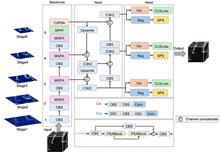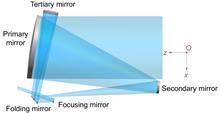
As the information age progresses rapidly, the demand for silicon photonic integrated circuits in optical communication, quantum precision measurement, artificial intelligence optical computing, and microwave photonics continues to grow. As an essential component of silicon photonic integrated circuits, optical isolators effectively prevent the backpropagation of optical signals, ensuring system stability and reliability. They are widely used in key technologies such as optical fiber communication, quantum communication, and laser systems. This paper reviews the research progress on on-chip integrated optical isolators, focusing on different implementation methods based on magneto-optic, acousto-optic, electro-optic, and nonlinear optical effects, discussing the advantages and challenges associated with each type. Finally, the paper explores future development directions and potential applications.
Electrowetting electronic paper employs a subtractive color mixing system for color display, which results in a smaller color gamut and potential color distortion. Additionally, it relies on ambient light's diffuse reflection, leading to insufficient brightness. To address these issues, this paper proposes a color space transformation and image adaptive enhancement algorithm for color electrowetting. The algorithm converts the image from the RGB color space to the HSV space, using CLAHE to evenly distribute saturation and improve color performance. The luminance channel is enhanced through guided filtering combined with an improved Retinex algorithm, preserving detail and edge information, and ensuring the electrowetting display maintains realistic visual effects under the same lighting conditions. Experimental results show that the algorithm improves PSNR, SSIM, FSIM, and FSIMc by 19%, 10.8%, 19.19%, and 19.54%, respectively. This algorithm significantly enhances the display performance of electrowetting electronic paper, laying a solid foundation for its commercialization.
To address the challenges of background complexity and target scale changes in synthetic aperture radar (SAR) images, especially in densely populated small-target scenes prone to false and missed detections, a multi-granularity feature and shape-position similarity metric method for ship detection in SAR images is proposed. First, a multi-granularity feature aggregation structure containing two branches is designed in the feature extraction stage. One branch decomposes the feature map cascade by Haar wavelet transform to expand the global receptive field to extract coarse-grained features. The other branch introduces spatial and channel reconstruction convolution to capture detailed texture information, thereby minimizing the loss of contextual information. The two branches effectively suppress the complex background and clutter interference by synergistically exploiting the interaction of local and non-local features to achieve accurate extraction of multi-scale features. Next, by utilizing the Euclidean distance and combining position and shape information, we propose a shape-position similarity metric to solve the problem of position deviation sensitivity in small target-dense scenes, thereby balancing the allocation of positive and negative samples. In a comprehensive comparison with 11 detectors from one-stage, two-stage, and DETR series on the SSDD and HRSID datasets, our method achieves mAP scores of 68.8% and 98.3%, and mAP50 scores of 70.8% and 93.8%, respectively. In addition, our model is highly efficient, with just 2.4 M parameters and a computational load of only 6.4 GFLOPs, outperforming the comparison methods. The proposed method shows excellent detection performance under complex backgrounds and ship targets of different scales. While reducing the false detection rate and missed detection rate, it has a low model parameter amount and computational complexity.
A kind of method of structural optimization design using structural deformation to compensate for optical misalignment is presented, which aims at decreasing the affection of imaging by gravity. First, on the basis of the characteristics of the optical system of a space camera, the structural forms of the main frame of the camera and the flexible support structure of the mirrors are determined. Secondly, taking the relative stiffness shift, relative inclination and face shape error of the secondary mirror, tertiary mirror, folding mirror, focusing mirror and main mirror under gravity as the optimization objectives, and the stability tolerance requirement of the optical system for each mirror as the constraints, the optimal parameters of the truss of main frame, the bearing cylinder thickness and the flexible support structure are obtained. Finally, the finite element analysis is carried out on the mode and Surface deformation of the camera, and sinusoidal sweep test and system wave aberration test are carried out on the camera. The results show that the first-order frequency of the camera is 36.7 Hz, and the average wave aberration of each field of the camera is 0.0655λ and 0.0701λ (λ=632.8 nm) under the two states of loading and flipping 180 degrees, respectively. It can be inferred that the wave aberration of the system can meet the optical design requirements after the gravity effect of the camera is disappeared. The optimized design of the camera support structure can be used as a reference for the structural design of space cameras.
To address the challenges posed by complex interference in retinal microsurgery, this study presents a deep learning-based algorithm for surgical instrument detection. The RET1 dataset was first constructed and meticulously annotated to provide a reliable basis for training and evaluation. Building upon the YOLO framework, this study introduces the SGConv and RGSCSP feature extraction modules, specifically designed to enhance the model's capability to capture fine-grained image details, especially in scenarios involving degraded image quality. Furthermore, to address the issues of slow convergence in IoU loss and inaccuracies in bounding box regression, the DeltaIoU bounding box loss function was proposed to improve both detection precision and training efficiency. Additionally, the integration of dynamic and decoupled heads optimizes feature fusion, further enhancing the detection performance. Experimental results demonstrate that the proposed method achieves 72.4% mAP50-95 on the RET1 dataset, marking a 3.8% improvement over existing algorithms. The method also exhibits robust performance in detecting surgical instruments under various complex surgical scenarios, underscoring its potential to support automatic tracking in surgical microscopes and intelligent surgical navigation systems.
Aiming at the issues of low recognition accuracy, high computational cost, and large model size caused by the complex background and small target scale in remote sensing images of military aircraft, a lightweight military aircraft target detection algorithm, namely YOLOv8-MA, integrating reparameterization and detail enhancement is proposed. Firstly, a multi-branch gradient flow feature extraction module is designed through reparameterization to enhance the model's inference speed. Secondly, in combination with efficient RepGFPN, redundant model structures are discarded and the P2 layer is incorporated to construct a multi-scale feature fusion network, mitigating the problem of small target information loss due to excessive downsampling. On this basis, a lightweight detection head is proposed by integrating GN convolution and detail enhancement to reduce the number of model parameters and the amount of computation. Finally, a focus coefficient is introduced into the Shape-IoU to form a new loss function, thereby improving the detection performance of the model. On the public military aircraft dataset MAR20, the mAP50 of this algorithm is as high as 97.9%, and the model size is as low as 2.1 MB. Compared with YOLOv8n, the number of parameters decreases by 74.7%, the amount of computation reduces by 40.7%, and the FPS increases by 14 f/s, demonstrating that it can effectively enhance the detection effect of military aircraft in remote sensing images.
In this research, an all-dielectric terahertz metasurface based on bound states in the continuum (BIC) is proposed. Each structural unit of the metasurface consists of two rectangle blocks with square cross-sections and a substrate. The substrate material is quartz, and the rectangle block material of the surface is lossless silicon. The symmetry of the metasurface is broken by tchanging the cross-section area of the rectangle block, and the quasi-BIC is excited. The resonance with extremely narrow linewidth is obtained. The transmission spectra with different asymmetric, structural and material parameters are studied using finite element method (FEM) and control variable method. Meanwhile, the Q factor of the proposed metasurface is calculated, which can reach 1.1006×104 and is higher than the Q factors from related listed references. In addition, this study is aimed at the limitations of the relatively limited research on the equivalent parameters of all-dielectric metasurfaces, the S-parameter extraction method is utilized to calculate and analyze the equivalent parameters of the proposed metasurface and the physical properties of the metasurface is studied from this perspective preliminarily.
In response to the deficiencies of existing steel surface defect detection algorithms in terms of resource consumption, detection accuracy, and efficiency, a lightweight steel defect detection algorithm based on YOLOv8n (FCM-YOLOv8n) is proposed. First, a frequency-aware feature fusion network is utilized to efficiently extract and integrate high-frequency information, reducing computational costs while enhancing detection speed. Second, a lightweight feature interaction module (Cc-C2f) is restructured to effectively preserve spatial and channel dependencies while reducing feature redundancy, thereby lowering model parameters and computational complexity. Finally, a multi-spectrum attention mechanism is applied to mitigate feature information loss in the frequency domain, improving the accuracy of detecting complex defects. Experimental results on the Severstal and NEU-DET steel defect datasets show that, compared to YOLOv8n, the FCM-YOLOv8n algorithm achieves a 2.2% and 1.5% improvement in mAP@0.5, respectively, with a 0.5 M and 1.5 G reduction in parameters and computational complexity. The FPS reaches 143 f/s and 154 f/s, respectively, demonstrating excellent real-time performance. The algorithm achieves an optimal balance between detection accuracy, computational cost, and efficiency, providing robust support for edge device applications. Further validation on the GC10-DET dataset shows a 2.9% improvement in mAP@0.5 compared to the baseline model, fully demonstrating the algorithm's exceptional generalization ability.
In 2024, under the background of the National Natural Science Foundation of China (NSFC) reform of the project application rules and scientific research funding management mechanism during the centralized acceptance period, the discipline of F05 "Optics and Optoelectronics" carried out funding strategy reform and practical work. Firstly, this work focuses on the application and funding situation of general projects, youth science fund projects, regional science fund projects, key projects, outstanding youth science fund projects and outstanding young scholar science fund projects, and systematically analyzes the application scale, funding ratio and change trend. Then, the distribution of project applications and funding support units is comprehensively sorted out. And the current frontier research hotspots and potential growth points of optics and optoelectronics are analyzed in combination with the classification of secondary codes. Finally, the comparative effect of the "responsible, credibility, and contribution" (RCC) evaluation mechanism on the fairness, justice and efficiency of the discipline funding system is revealed. The purpose of this work is to provide a detailed reference framework for experts and scholars who apply for NSFC funding in the next year and stimulate innovation.














